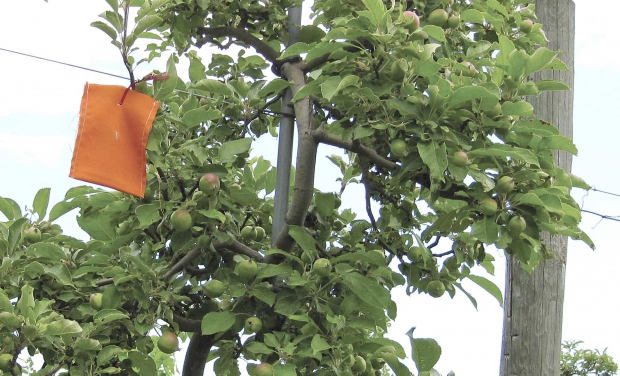
MSU researchers developed a device in which a lure is inside an insecticide-soaked pouch. Oriental fruit moth males that contact the pouch are killed after seconds of contact. (Courtesy Juan Huang)
In mating disruption using pheromones, males of a species—usually moths that produce larvae that feed on fruit—are so overwhelmed by powerful sex attractants that they can’t find the object of their intended affection. The females are lost in a plume of perfume.
But—since even a blind squirrel finds a nut sometimes—wouldn’t it be better to lure the males and kill them when they find the object emitting the attractive odor? Be done with them, don’t tease them?
Dr. Matt Grieshop, a Michigan State University entomologist, worked last year with Dr. Larry Gut and postdoctorate Juan Huang to develop a device that would do that. They tested it on oriental fruit moths in wind tunnels, refined it, and this year plan to take it to the field for further testing.
A key concept is to use a small amount of pheromone so that males aren’t overwhelmed in a plume but are attracted to what they think is a female moth.
This phony female is inside an insecticide-treated pouch. The male makes contact with the pouch. Four seconds of contact is enough to kill the male.
“Mating disruption functions by distracting males for a limited time,” Grieshop said. He used codling moth as an example. Each male potentially has three hours of mating time per night during a four-day lifespan, so each false approach uses about one twelfth of a male’s mating lifespan. “Attract and kill uses all of a male’s remaining lifespan,” he said.
Current attract-and-kill technology uses droplets of wax or polymers that contain both the pheromone and the toxicant. A droplet is a very small surface for the moth to contact, and there is a risk that the moths’ sensory systems will be overwhelmed and they won’t even touch the formulation, he said.
The device the MSU team developed uses very low rates of pheromone, making it cheaper to use. The rate is about a one-thousandth of that found in the twist-tie dispensers used in mating disruption. Moreover, it appears that 50 lures per acre will be enough, a quarter of what orchardists use in mating disruption.
On the other side, the insecticide used to treat the pouch is less diluted—about ten times as potent as dilute spray material. In the tests, this resulted in 100 percent knockdown or kill within an hour of contact.
Grieshop, who runs the Organic Pest Management Laboratory at MSU, says this technique probably doesn’t meet organic standards. The insecticide he used is deltamethrin, a synthetic pyrethroid that is a neurotoxin with fast knockdown activity. It remains potent in the pouch for a full year.
While it’s not organic,no insecticide is sprayed onto trees or fruit. There are no insecticide residues on fruit.
The lure is highly selective, so it’s safer for natural enemies and nontarget species. And, he said, “Just because current NOP-compliant insecticides are not good candidates for this technology does not mean that future NOP insecticides might not fit the bill.”
“We’re pretty excited about this,” he told growers at the Northwest Michigan Orchard and Vineyard Show in Traverse City, Michigan, in January.
He wants to conduct large-scale field trials on oriental fruit moth this year and proceed to commercialize the device.
At the same time, he wants to try it out on other species. Japanese beetles, obliquebanded leafrollers, and codling moths are likely candidates because they have good pheromone attractants.
“Insects must exhibit contact behavior in response to a semiochemical,” he said. He’d like to go after spotted wing drosophila, but a better semiochemical is needed for that, he said. •






I just heard Matt Grieshop talk about this at our CGI (Chestnut Growers, Inc) Clarksville meeting with Matt. He was very excited, and so were we, as Japanese Beetle and Potato Leafhopper are pests of edible chestnuts. We wish him the best in his field endeavors and hope you will be giving us updates on this research, especially as it pertains to these other species. Thank you.
Where can these be purchased?